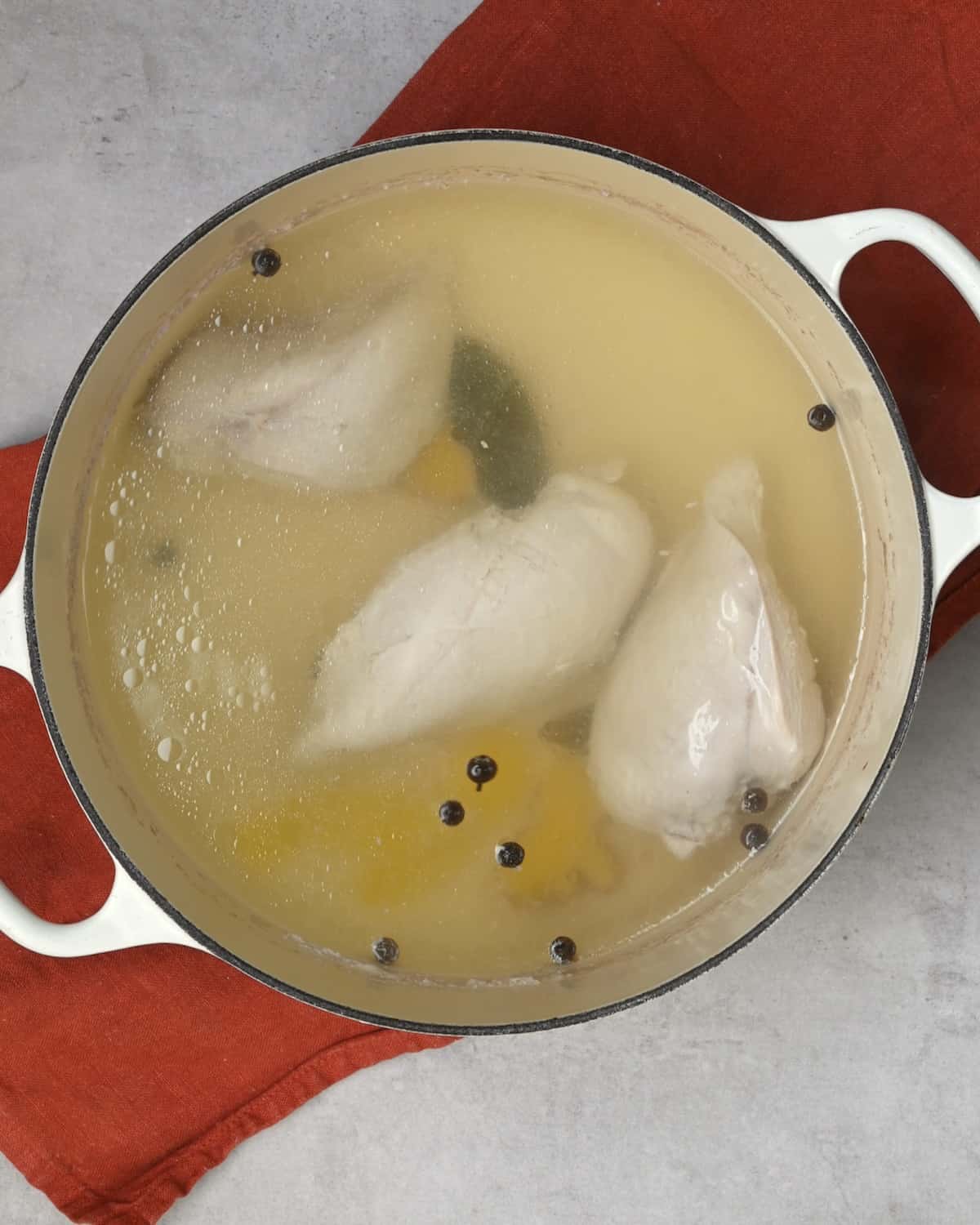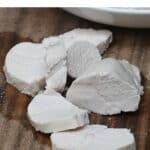This post may contain affiliate links. Please read our disclosure policy.
How to boil chicken breasts until juicy and tender with just a handful of simple ingredients. A meal-prep protein, perfect for slicing and shredding into heaps of meals!

Crockpot shredded chicken and Instant Pot chicken breasts are some of my favorite ways to prepare chicken breast for slicing and shredding into an almost endless variety of dishes. However, for those who own neither, learning how to boil chicken breasts on the stovetop is practically a must-know kitchen basic.
With just a handful of pantry basics and a heavy-based saucepan, you can pull together this boiled chicken breast recipe in just 6 simple, fuss-free steps. Boiling chicken breasts (also called poaching chicken) is a quick and easy way to prepare super tender and juicy chicken.
Once cooked, boiled chicken breast is a healthy, low-fat, budget-friendly, versatile meal-prep protein for everything from salads (like chicken salad or in a Caesar salad) and soups to sandwiches, casseroles, dips, Mexican-inspired dishes (like tacos, burritos, quesadillas, and enchiladas), and much more.


Want to save this recipe?
The Ingredients
- Chicken breasts: I use boneless, skinless chicken breast halves – fresh or frozen (thawed).
This method works with large bone-in chicken breasts too, but the cooking time increases (closer to 25-30 minutes). Use similar-sized pieces so they cook evenly.
- Water: You only need regular water, though you can use chicken broth for more flavor.
- Salt: To season the water (and thus, the chicken).
- Seasonings: Any seasonings are optional but a great way to infuse the meat with more flavor. They also help eliminate the boiled chicken smell.
- Bay leaves,
- Whole peppercorns,
- Lemon peel,
- Ginger.

How to Boil Chicken Breast
Place the chicken in a large, heavy-based saucepan and add the seasonings (if using).
Cover the chicken with enough cold water so it’s fully submerged, then bring it to a boil over medium-high heat.
Then use a spoon/skimmer to skim off the layer of scum that has formed at the top of the pot.
The boiling process also helps to minimize any strong odors, making this a smell-free cooking method.

How Long to Boil Chicken Breasts
Once the water is boiling, immediately reduce it to a simmer. Then cover the pot with a lid and simmer the boneless chicken breast halves for 8-15 minutes. The exact time will depend on the size/thickness of the chicken.
Use a meat thermometer to check that the chicken breasts’ internal temperature has reached 160-165ºF/71-74ºC.
Then remove the chicken from the pot and allow it to rest for at least 10 minutes to allow the juices to settle/redistribute.
Finally, carve or shred the chicken (by hand, fork, hand mixer, or stand mixer) to your liking, and enjoy!

How to Store and Freeze Boiled Chicken Breasts
Fridge: Allow the chicken to cool (but don’t leave it at room temperature for longer than 2 hours). Then store it in an airtight container in the refrigerator for 3-4 days.
Freezer: You can freeze the boiled chicken breast whole, sliced, or shredded in Ziplock bags (spread flat with the excess air squeezed out) for up to 3 months. I like to do so in portions. Allow it to thaw in the refrigerator overnight when needed.
Reheat: Add it to a saucepan with a splash of water/broth and reheat, covered, until piping hot. OR wrap it in foil and bake at 350ºF/175ºC until piping hot.

Top Tips for Boiling Chicken Breasts
- Seasoning is optional: Depending on how you plan to use the meat, a bit of salt & black pepper may be all you need in the boiling liquid. However, the seasonings I’ve used are also great for getting rid of that boiled chicken smell.
- Don’t overcrowd the pot: For most even cooking, it’s best to cook the chicken in a single layer in the saucepan.
- Use a cold start: This cooks chicken gently for the most tender meat. Plunging chicken directly into boiling water produces tough meat and uneven cooking.
- Get rid of the chicken scum: After bringing it to a boil, a layer of “scum” will rise to the top of the pot. You can remove it with a slotted spoon or a skimmer. This is important if you want to use the cooking liquid afterward.
- Allow the chicken to rest: During this time, the juices within the chicken settle and redistribute for perfectly juicy chicken breasts.

FAQs
The easiest way to ensure the chicken is ready is to use a meat thermometer inserted in the thickest part of the chicken. Ensure it reads 165ºF/74ºC. If you don’t have a meat thermometer, look for firm but tender chicken (a fork should go through without resistance) with no pink remaining in the center.
Just like any method for cooking chicken, if you boil chicken for too long, it will become rubbery. The trick is to get it to reach 165ºF/74ºC, then remove it from the liquid.
There are several ways you can add more flavor to boiling chicken (since boiling actually removes some of the flavor from the meat). These include cooking it in chicken broth or a well-seasoned liquid.
Along with salt and pepper, you could add aromatics (like garlic, ginger, and/or onion), other vegetables (like carrots and celery), fresh or dried herbs (thyme, rosemary, bay leaves, parsley, etc.), whole spices, etc. You can even replace some water/broth with dry white wine or beer.
Aside from this recipe, I also love using 1-2 garlic cloves/ garlic powder, a bay leaf, thyme and/or rosemary sprigs, lemon peel, and peppercorns.
The poaching liquid picks up the chicken juices turning it into a mild “chicken broth” you can use in many recipes (like sauces and gravy), to cook rice or pasta, or even sip on its own. To save it for later, freeze the broth in Ziplock bags or an ice cube tray.
I prefer to thaw the meat first for the most even cooking, but technically you can boil it from frozen. This usually takes 5-8 minutes extra, but use a thermometer to ensure it’s cooked.
More Simple Chicken Recipes
- Juicy Air Fryer Chicken Breast
- Perfect Oven Baked Chicken Breast
- Crispy Fried Chicken Breast
- Chicken Brine
- Chicken Crust Pizza Topped with Caesar Salad
- Best Chicken Soup
If you try this recipe for boiling chicken breasts, let me know how it goes in the comments below. I’d appreciate a recipe card rating and would love to see your recipe recreations – tag me on Instagram @Alphafoodie!

How to Boil Chicken Breasts (Smell Free Method!)
Ingredients
- 25 oz boneless skinless chicken breast 3 medium-sized; bone-in will work too but takes longer to cook
- 8 cups water or more – it needs to cover the chicken; use chicken broth for more flavor
- 1 tsp salt
Optional spices (refer to the FAQs for more inspiration)
- 2 bay leaves
- few whole peppercorns
- 2 slices lemon peel
- 2 slices ginger small
Instructions
- Place the chicken in a large, heavy-based saucepan and add the seasonings (if using).
- Cover the chicken with enough cold water so it's fully submerged, then bring it to a boil over medium-high heat.
- Use a spoon/skimmer to skim off the layer of scum that has formed at the top of the pot.
- Once the water is boiling, immediately reduce it to a simmer. Then cover the pot with a lid and simmer the chicken for 8-15 minutes. The exact time will depend on the size/thickness of the chicken.Use a meat thermometer to check that the chicken breasts' internal temperature has reached 160-165ºF/71-74ºC.
- Remove the chicken from the pot and allow it to rest for at least 10 minutes to allow the juices to settle/redistribute.Finally, carve or shred the chicken (by hand, fork, hand mixer, or stand mixer) to your liking, and enjoy!
Notes
- Seasoning is optional: Depending on how you plan to use the meat, a bit of salt & black pepper may be all you need in the boiling liquid. However, the seasonings I’ve used are also great for getting rid of that boiled chicken smell.
- Don’t overcrowd the pot: For most even cooking, it’s best to cook the chicken in a single layer in the saucepan.
- Use a cold start: This cooks chicken gently for the most tender meat. Plunging chicken directly into boiling water produces tough meat and uneven cooking.
- Get rid of the chicken scum: After bringing it to a boil, a layer of ‘scum’ will rise to the top of the pot. You can remove it with a slotted spoon. This is important if you want to use the cooking liquid afterward.
- Allow the chicken to rest: During this time, the juices within the chicken settle and redistribute for perfectly juicy chicken breasts.
Nutrition
Nutrition information is automatically calculated, so should only be used as an approximation.













